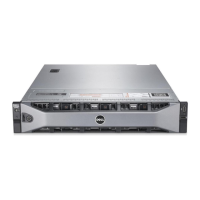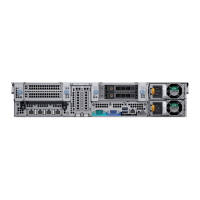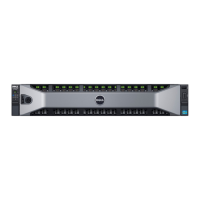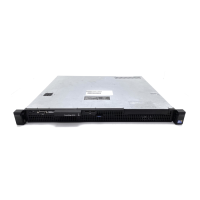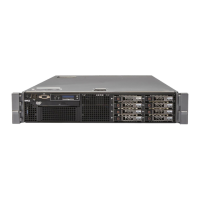Do you have a question about the Dell PowerEdge R810 and is the answer not in the manual?
Description of front-panel components, buttons, and indicators.
Brief text messages referring to events logged in the System Event Log (SEL).
Messages indicating possible system problems and recommended actions.
Selecting between BIOS and UEFI boot modes for operating system installation.
Steps to enter the System Setup program using the F2 key during startup.
Overview of configurable options within the System Setup program.
Configuration for boot mode (BIOS/UEFI) and boot sequence.
Configuration of system and setup passwords, and Trusted Platform Module (TPM) security.
Steps to access the UEFI Boot Manager using the F11 key.
Overview of system and setup password security features.
Step-by-step instructions for setting a system password for security.
Procedures to keep password security enabled or disable it.
Pre-boot environment for viewing and setting iDRAC6 and server parameters.
Detailed steps for safely opening and closing the system chassis cover.
Information on connecting, removing, and installing hard drives and drive blanks.
Steps to prepare and remove a hard drive from its carrier.
Procedure for installing a hard drive carrier with a drive into the system.
Steps to separate a hard drive from its carrier.
Procedure to mount a hard drive into its carrier.
Detailed steps for safely removing an optical drive from the system.
Detailed steps for safely installing an optical drive into the system.
Overview of system power supply modules and redundancy modes.
Procedure for safely removing a power supply module from the system.
Procedure for installing a new power supply module into the system.
Detailed steps for removing the system's cooling shroud.
Detailed steps for installing the system's cooling shroud.
Description of the front-chassis assembly and its mounting.
Procedure for sliding the front-chassis assembly away from and back into the chassis.
Details on supported memory types, capacities, speeds, and socket configurations.
Best practices for installing memory modules to ensure optimal performance and compatibility.
Step-by-step instructions for installing memory modules into the system sockets.
Step-by-step instructions for safely removing memory modules from the system sockets.
Step-by-step guide for installing PCIe expansion cards into the system.
Step-by-step guide for safely removing PCIe expansion cards from the system.
Details on processor configurations, installation, and related components like heat sinks.
Step-by-step guide for safely removing a processor and its heat sink.
Step-by-step guide for safely installing a processor, including heat sink application.
Overview of the system board assembly, its components, and removal/installation.
Detailed steps for safely removing the system board assembly.
Detailed steps for safely installing the system board assembly.
Diagnosing and resolving problems with the system's power supply units.
Diagnosing and resolving problems related to system memory modules.
Procedures for diagnosing and resolving issues with system hard drives.
Diagnosing and resolving problems with SAS or PERC storage controller cards.
Steps to diagnose and resolve issues with installed expansion cards.
Diagnosing and resolving issues related to the system's processors.
Procedure to reset system and setup passwords using a jumper.
Contact information and methods for reaching Dell technical support and customer service.
Description of front-panel components, buttons, and indicators.
Brief text messages referring to events logged in the System Event Log (SEL).
Messages indicating possible system problems and recommended actions.
Selecting between BIOS and UEFI boot modes for operating system installation.
Steps to enter the System Setup program using the F2 key during startup.
Overview of configurable options within the System Setup program.
Configuration for boot mode (BIOS/UEFI) and boot sequence.
Configuration of system and setup passwords, and Trusted Platform Module (TPM) security.
Steps to access the UEFI Boot Manager using the F11 key.
Overview of system and setup password security features.
Step-by-step instructions for setting a system password for security.
Procedures to keep password security enabled or disable it.
Pre-boot environment for viewing and setting iDRAC6 and server parameters.
Detailed steps for safely opening and closing the system chassis cover.
Information on connecting, removing, and installing hard drives and drive blanks.
Steps to prepare and remove a hard drive from its carrier.
Procedure for installing a hard drive carrier with a drive into the system.
Steps to separate a hard drive from its carrier.
Procedure to mount a hard drive into its carrier.
Detailed steps for safely removing an optical drive from the system.
Detailed steps for safely installing an optical drive into the system.
Overview of system power supply modules and redundancy modes.
Procedure for safely removing a power supply module from the system.
Procedure for installing a new power supply module into the system.
Detailed steps for removing the system's cooling shroud.
Detailed steps for installing the system's cooling shroud.
Description of the front-chassis assembly and its mounting.
Procedure for sliding the front-chassis assembly away from and back into the chassis.
Details on supported memory types, capacities, speeds, and socket configurations.
Best practices for installing memory modules to ensure optimal performance and compatibility.
Step-by-step instructions for installing memory modules into the system sockets.
Step-by-step instructions for safely removing memory modules from the system sockets.
Step-by-step guide for installing PCIe expansion cards into the system.
Step-by-step guide for safely removing PCIe expansion cards from the system.
Details on processor configurations, installation, and related components like heat sinks.
Step-by-step guide for safely removing a processor and its heat sink.
Step-by-step guide for safely installing a processor, including heat sink application.
Overview of the system board assembly, its components, and removal/installation.
Detailed steps for safely removing the system board assembly.
Detailed steps for safely installing the system board assembly.
Diagnosing and resolving problems with the system's power supply units.
Diagnosing and resolving problems related to system memory modules.
Procedures for diagnosing and resolving issues with system hard drives.
Diagnosing and resolving problems with SAS or PERC storage controller cards.
Steps to diagnose and resolve issues with installed expansion cards.
Diagnosing and resolving issues related to the system's processors.
Procedure to reset system and setup passwords using a jumper.
Contact information and methods for reaching Dell technical support and customer service.
| Form Factor | 2U rack server |
|---|---|
| Chipset | Intel 7500 chipset |
| Memory Slots | 32 DIMM slots |
| Processor | Up to four Intel Xeon 6500/7500 series processors |
| Memory | Up to 512GB (32 DIMM slots): 1GB/2GB/4GB/8GB/16GB DDR3 |
| Storage | Up to six 2.5" SAS or SATA drives |
| RAID Controller | PERC H700, PERC H800 |
| Network | Four embedded Broadcom NetXtreme II 5709c Gigabit Ethernet NICs |
| Power Supply | Redundant 1100W or 750W AC power supplies |
| Expansion Slots | 6 x PCIe Gen2 slots (3 x x8, 3 x x16) |
| Operating System Support | Red Hat Enterprise Linux, SUSE Linux Enterprise Server, VMware ESXi |
